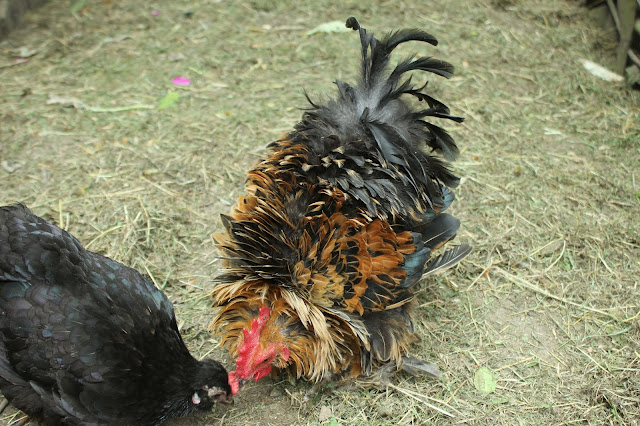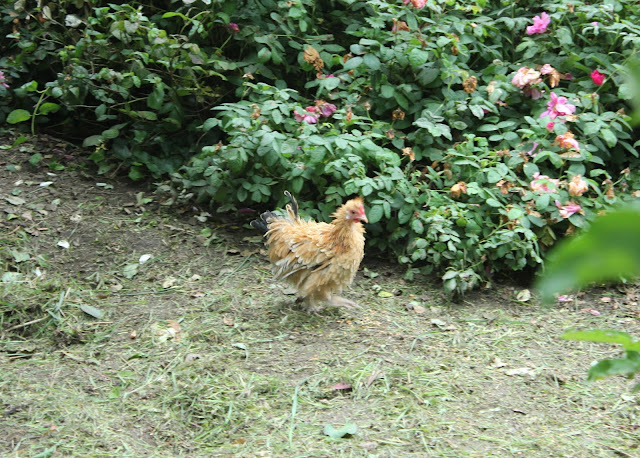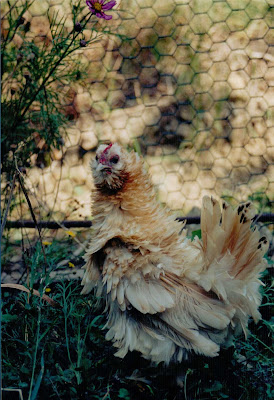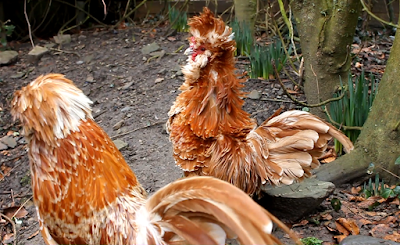In the first part of this article I discussed aspects of the perceived wisdom on Frizzled birds and how and why this could impact on choices when it came to picking birds for a back yard or in particular a forest garden. If you have just landed on this subject and want to read the first part, you can find it here.
How frizzling affects behaviour
 Spike
is a fine example of a Polish Frizzle and has also something which I
believe well illustrates the dilemma faced by the Frizzled bird and why
it is perhaps more interesting, for me, to look at the psychological
issues involved in frizzling rather than the genetic ones.
Spike
is a fine example of a Polish Frizzle and has also something which I
believe well illustrates the dilemma faced by the Frizzled bird and why
it is perhaps more interesting, for me, to look at the psychological
issues involved in frizzling rather than the genetic ones.I'm certain you can see his personality shining through here. Both he and his brother Rupert pictured in my previous article with their father Diavolo are gentle birds. Now and again they take it upon themselves to assert their territorial rights but it is done with a great deal of ritual and I might add, very little if any physical contact.


You can see in this comparison how Spike's hackle feathers differ from that of his brother and how, as we will see below, he is sending out clear signals to the others in the flock. This can get him into difficulties from time to time and this is where keeping Frizzles in a forest garden comes into its own because they have a very simple way of extricating themselves from potentially threatening situations. The fact that Spike and Rupert are co-rulers of a hen house and thus dominant males, can put them in the firing line for potential conflict from other aspiring cockerels. Rupert however, see below, just looks quietly confident, whereas Spike due to his feathering has the potential for sending out different messages.
 |
| Bob the Irreplaceable |
Just holding the head downwards to show a hen a tasty snack can lead to a contretemps as those hackle feathers look like the prelude to a show-down, as above, with Chocolatte. With my first ever frizzled birds, I was aware that they either gained dominant positions, almost by default or were keeping a low profile around the under-plantings of the forest floor. This is why I wrote earlier that I knew they could control their own feathers and actually make them lie flat against the body. Not only does this remove the 'puffed-up' look but it also makes them slimmer and smaller and a lot less visible. I have seen Sweep use this ability on several occasions back when he was a youth and wanted to avoid conflict. Furthermore, young Frizzles such as Honeycomb, below, will still adopt this feather-lowering option when moving between territories. For a hen Frizzle the stakes are rather higher, as I have always found female fights are a lot more physical and potentially dangerous than cockfights. In the main however, over time and as our birds got used to having Frizzles amongst them, the whole flock began to interpret these signals differently. It still does remain a fact though, that of all the hen houses/coops, there is not one where the dominant cockerel and/or hen has not been a Frizzle.
The lowering of the feathers is again something which happens either involuntarily or by design when it rains or the Frizzle becomes too hot sunbathing. Again this ability to control or have the feathers controlled by temperature or humidity is something which enables the Frizzle to enjoy life in the freedom of movement a forest garden provides. There are however times when it does become necessary to intervene.
Frizzles and emotions
One of the criteria by which man has always wanted to distance himself from animals and birds is by his idea that sentience is the preserve of humans. Well from my observations that is just not true. Birds and animals exhibit a whole gamut of emotions and it was my first ever rehomed Frizzle, who showed me that birds can get depressed. Frizzante as we called her arrived depressed, I thought this was quite natural because she and all the other denizens of the forest garden in which she lived had lost their 'keeper'. However, I was told that she had been in a monogamous relationship with a frizzled rooster, who had died the year before she came to live with us. Here she is on her first day, she even looks sad.
 |
| The Unfaithful Orlando with Lucy the Brahma |
Luckily my Sebright cockerel and Frizzante formed a bond and although it was not a lasting one and although she laid six eggs, she never became broody. Orlando was the most laid-back bird we have ever had and his personality along with that of my next purchase, an Ardenner cockerel 'Raffles', worked wonders on Frizzante, who even grew back the plumage she had lost through stress.
My two Ardenner hens and Dorothy the Wyandotte cross made up the rest of our little starter flock. Frizzante steered clear of Chicklette and Poulie, who as my first two hens and sisters had formed a very dominant pair. Instead the Frizzle rather cleverly, I thought, continuously attempted to balance up this power couple, by making friends with Dorothy but was snubbed at every attempt. It is here, I think, where Frizzles come into their own, they are totally determined and will always try to make things work. In the end my little flock did achieve harmony and as it quickly grew ever bigger, that strength of will from Frizzante and the sybaritic insouciance of Orlando carried down through the generations. It has absolutely coloured the whole dynamic of the flocks we have today. This was also an important lesson for me to witness the strength and depth of emotions within this little hen and it helped me so much when dealing with later Frizzled offspring from the same bloodline, who became so depressed over our weather and in Squeaky's case below, a fall from power. As I explained in my previous post, I do have bloodline of unusually fine feathered Frizzles, whereas my Polish and Cochin Frizzles are well upholstered in cold weather.
My two Ardenner hens and Dorothy the Wyandotte cross made up the rest of our little starter flock. Frizzante steered clear of Chicklette and Poulie, who as my first two hens and sisters had formed a very dominant pair. Instead the Frizzle rather cleverly, I thought, continuously attempted to balance up this power couple, by making friends with Dorothy but was snubbed at every attempt. It is here, I think, where Frizzles come into their own, they are totally determined and will always try to make things work. In the end my little flock did achieve harmony and as it quickly grew ever bigger, that strength of will from Frizzante and the sybaritic insouciance of Orlando carried down through the generations. It has absolutely coloured the whole dynamic of the flocks we have today. This was also an important lesson for me to witness the strength and depth of emotions within this little hen and it helped me so much when dealing with later Frizzled offspring from the same bloodline, who became so depressed over our weather and in Squeaky's case below, a fall from power. As I explained in my previous post, I do have bloodline of unusually fine feathered Frizzles, whereas my Polish and Cochin Frizzles are well upholstered in cold weather.
 Sweep's life too was made miserable by his inability in old-age to cope with cold weather. He would, like Squeaky (above) before him, spend his time either inside near the woodstove or at the window ready to come in again. I just got the idea that he would benefit from some permanent extra warmth and used as a model, the turkey saddles, I had seen employed on the farm when I was a child. Sweep's coat was designed for the outdoor life he had always loved in
his youth and allowed him to continue to enjoy it in old-age, he could even fly up to the perch in it to roost. I also found that on very cold nights he needed to sleep in it too. You can see how his stance echoes his Sebright blood. Seeing him standing like this and showing such confidence, also gave me good visual signals that he was feeling fine again!
Sweep's life too was made miserable by his inability in old-age to cope with cold weather. He would, like Squeaky (above) before him, spend his time either inside near the woodstove or at the window ready to come in again. I just got the idea that he would benefit from some permanent extra warmth and used as a model, the turkey saddles, I had seen employed on the farm when I was a child. Sweep's coat was designed for the outdoor life he had always loved in
his youth and allowed him to continue to enjoy it in old-age, he could even fly up to the perch in it to roost. I also found that on very cold nights he needed to sleep in it too. You can see how his stance echoes his Sebright blood. Seeing him standing like this and showing such confidence, also gave me good visual signals that he was feeling fine again!
I made a film of Squeaky's story and although old and filmed and edited pre-Open Shot and before I got a Birthday present of a better film camera, I think it does illustrate the essence of Frizzle.
Sue
RETURN TO CONTENTS PAGE
© 2016 Sue Cross
In
the next article I'll look further into the determined nature of Frizzles how it can be amazingly helpful and on occasions harmful and strategies for preventing the latter.
Meanwhile
all the very best and if you have enjoyed this piece and found it
interesting and/or useful please feel free to join the blog, subscribe
to my youtube channel and of course to ask questions or comment and
share your own experiences.
Sue
RETURN TO CONTENTS PAGE
© 2016 Sue Cross
RELATED ARTICLES
Choosing Chickens Polish, Beauty, Brains & Rusticity.
It's hard to believe that a creature which looks so frou-frou can be anything but ornamental and therefore totally unsuited to a backyard or smallholding but in the following article...read more
Frizzles for a Forest Garden Part 1
In some countries, such as here in France, Frizzles are often viewed as
an individual breed rather than a form of feather mutation, which can
occur across several races...read more






















